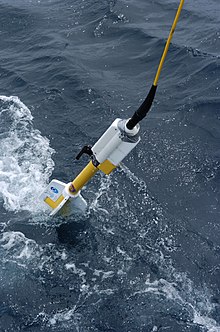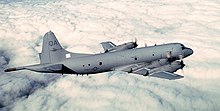Magnetometer

A magnetometer (also known colloquially as a Teslameter or Gauss meter ) is a sensory device for measuring magnetic flux densities . Magnetic flux densities are measured in the unit Tesla (T), and the usual measuring ranges of magnetometers are in a size range of approximately 10 −15 T to 10 T. Due to the large range of values, different measuring methods are used under the term "magnetometer".
Types
Here is a list of the most common magnetometers:
- Hall sensors
- Förster probes or saturation core magnetometer ( Fluxgate or second-harmonic detector )
- fixed and rotating coils (induction), e.g. B. Vibrating Sample Magnetometer
- Optically pumped magnetometers, such as alkali vapor magnetometers (e.g. with atomic rubidium or cesium vapor)
- SQUIDs measure the physically smallest measurable strength of the magnetic flux density with a superconducting ring ( Josephson effect ) . Although they are in principle the most sensitive magnetometers, their use is very complex due to the low temperatures required for superconductivity and the associated installations (e.g. cryostats ). They are only used in the laboratory.
- Proton magnetometers such as B. Overhauser magnetometer
- Magnetometer based on Bose-Einstein condensates (BEC magnetometer) with a sensitivity of 10 −9 T and a spatial resolution of 3 µm .
- Kerr magnetometer
- Faraday magnetometer (use of the Faraday effect )
There are also other sensors for magnetic flux densities, but these are rarely used under the term magnetometer. They are not as sensitive and low-noise as the ones mentioned so far:
- XMR sensor; Thin-film sensors that change their resistance directly under the influence of the magnetic flux and are therefore called "X-MagnetoResistiv", such as GMR sensor ( giant , dt. "Huge, huge", GMR effect ), AMR sensor ( anisotropic , dt . "Anisotropic" AMR effect ) or CMR sensors ( colossal , dt. "Oversized").
- Field plate .
Although XMR and Hall sensors are not as sensitive as the above, due to their simple structure ( semiconductor technology ) and the associated low-cost production , they are used en masse for simple tasks. These include compasses , proximity switches , hard drives , current sensors .
application
One of the classic tasks of a magnetometer is to measure the earth's magnetic field and its fluctuations ( geomagnetics ). If local deviations of the magnetic field occur on the earth's surface, this indicates ferromagnetic materials in the subsurface. These disturbances can be used to detect objects as diverse as z. B. ore deposits , submarines , contaminated sites (e.g. duds ) or archaeological structures are used.
Magnetometers are very important in space travel . They are used there as position sensors and are used to determine the position of a satellite.
Magnetometers used by aircraft are also known under the abbreviation MAD ( magnetic anomaly detector ) , especially in the military sector . In order to minimize the influence of ferromagnetic components of the aircraft, such magnetometers are either dragged on a rope behind the aircraft or, for example, housed in a spike-like extension of the rear of the fuselage.
Magnetometers are used in smartphones , navigation devices and VR headsets to implement a magnetic compass or to reference the signals from the acceleration sensors to determine the position.
Earth's magnetic field
The earth's magnetic field , which only approximately a dipole field is is outside of about by electrical fields in the upper atmosphere caused by polar lights , but also influences can be visible from the interior of the earth through the body with its own magnetism. A metal-containing melt, for example, adopts the orientation of the earth's magnetic field as it cools. If their position or the poles of the magnetic field change later, the cooled metal generates an interference field. This can be done on a large scale through an ore, but also on a small scale through a nail hidden in the wall.
The deflection of a magnetic needle is, however, changed far too little by such interference fields for it to be seen with the naked eye. Therefore, for mechanical magnetometers - in addition to an almost frictionlessly mounted magnetic needle - strong reading optics are required. In addition to the purely mechanical measurement, the Hall effect can be used to measure electrical magnetic fields. A more modern method is measurement with a proton precession magnetometer , which is based on subatomic interactions.
history
The first magnetometer was developed in 1832 by the German physicist and mathematician Carl Friedrich Gauß , who gave the description of the measuring device on December 18, 1833 in a lecture on the earth's magnetic field, Intensitas vis magneticae terrestris ad mesuram absolutam revocata (The strength of earth's magnetism reduced to absolute measurements) before the Royal Society, which was subsequently printed. In 1837 Gauß developed his invention, the unifilar magnetometer (a magnetic needle suspended on a torsion thread), with which measurements were time-consuming, together with Wilhelm Eduard Weber, to create the temperature-stable and fast-measuring bifilar magnetometer (a magnetic rod suspended on two threads).
Before the two developments by Gauss, an absolute measurement of the strength of magnetic fields was not possible. Alexander von Humboldt used the following method with devices from the French Gambey to determine strength: A magnetic needle or a magnetic rod is hung on a thread so that the needle or rod can rotate freely horizontally. The needle or the rod will align itself according to the locally effective earth's magnetic field. If the needle is brought outside of this line by an impact, it swings back to the starting position according to the strength of the applied magnetic field, but due to its angular momentum beyond it and then back again by the force of the magnetic field etc. The duration of this pendulum movement around the original orientation , the oscillation period, allows the calculation of the strength of the acting force, i.e. the magnetic field , if the torsional moment of inertia is known . An exact measurement, however, requires a constant strength of the magnet itself, which can change over time and especially with temperature. So it was not possible to calibrate the measurements. Gauss solved the problem by adding a second magnet to this experimental arrangement, the action of the first on the second freely suspended magnet competing with the earth's magnetic field. By bringing the two magnets in different positions to each other and measuring each time, the current strength of the measuring magnets can be calculated by comparison and the magnetic strength of the earth's magnetic field can be objectively determined. The positions that are favorable for the comparison are referred to as Gaussian positions.
Gauss achieved the precise determination of the different angles by attaching a small mirror to the magnet. With the help of a small telescope with crosshairs, he observed the mirror image of a scale about 6 m away from the structure. You can now easily calculate the current angle of rotation of the mirror by observing the position of the crosshairs on the scale. A replica of this experiment made on behalf of Wilhelm Weber can be found both in the iron-free wooden house that Gauß had built for his magnetic investigations in the garden of the Göttingen observatory and in the historical collection of the Faculty of Physics at the University of Göttingen.
See also
literature
- Pavel Ripka (Ed.): Magnetic sensors and magnetometers. Artech House, Boston 2001, ISBN 1-58053-057-5 .
Web links
- Lecture by Councilor Gauß in Göttingen on the need for a special local for magnetic observations .
- UNI Göttingen: Göttingen Digitization Center . B. "gauss magnetometer"
Individual evidence
- ↑ Phil Schewe, Ben Stein: A New BEC Magnetometer. In: Physics News Update No. 785 (1). July 17, 2006, archived from the original on April 10, 2013 .
- ↑ Osiris was always there , NZZ, January 13, 2017, title of the print edition
- ↑ Accelerometers, magnetometers and gyrometers: What sensors Windows 8 has to offer. In : entwickler.de. February 15, 2012, accessed September 23, 2012 .
- ↑ Description of the bifilar magnetometer


